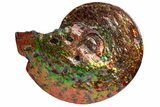This Specimen has been sold.
11.7" Ammonite Fossil With Mosasaur Bite Marks - Precious Ammolite!
This is a truly spectacular ammonite fossil (Placenticeras meeki), collected from the Bearpaw Shale of Alberta, Canada. It's entirely preserved as brilliant ammolite, an iridescent, opal-like gemstone of red, orange, yellow, green blue, and purple hues. This spectacular specimen features deep impressions on both sides that correspond with the top and bottom jaws of a giant Mosasaur. Lavender purple flashes reside in some of the additional bite marks and are a particularly exciting feature. This is without a doubt one of the finest ammolite specimens to come through FossilEra!
This remarkable ammonite fossil is in excellent condition with stunningly vivid colors on both sides. The ammolite exhibits many of the characteristics of a near perfect specimen that is so highly sought after.
These complete, well-preserved, ammolite fossils are quite rare and truly special. The Canadian government considers them part of the “National Treasures of Canada”. For this reason, all complete specimens must be inspected and registered by the Alberta provincial government. Each ammonite then receives a number and is entered in the provincial database. A cultural property export permit is required for them to be exported from the province. Documentation will be provided with the specimen upon request. An acrylic and metal display stand will accompany your purchase for your ultimate 360 degree viewing pleasure.
Please contact us for any additional information about this specimen, payment or shipping.
This remarkable ammonite fossil is in excellent condition with stunningly vivid colors on both sides. The ammolite exhibits many of the characteristics of a near perfect specimen that is so highly sought after.
These complete, well-preserved, ammolite fossils are quite rare and truly special. The Canadian government considers them part of the “National Treasures of Canada”. For this reason, all complete specimens must be inspected and registered by the Alberta provincial government. Each ammonite then receives a number and is entered in the provincial database. A cultural property export permit is required for them to be exported from the province. Documentation will be provided with the specimen upon request. An acrylic and metal display stand will accompany your purchase for your ultimate 360 degree viewing pleasure.
Please contact us for any additional information about this specimen, payment or shipping.
About Ammolite
Ammolite is an opal-like gemstone found primarily in Alberta, Canada. It is a kind of fossilized shell from ammonites, which in turn are composed primarily of aragonite, the same mineral contained in nacre (mother-of-pearl). The shell's microstructures are often preserved. In 1981, ammolite was given official gemstone status by the World Jewellery Confederation (CIBJO).
An iridescent opal-like play of color is shown in fine specimens, mostly in shades of green and red; howver, all the spectral colors can be seen. This iridescence is due to the aragonite's microstructure: unlike most other gems, whose colors come from light absorption, the iridescence in ammolite comes from interference with the light that rebounds from stacked layers of thin platelets that make up the aragonite. The thicker the layers, the more reds and greens are produced; the thinner the layers, the more blues and violets predominate. Blues and especially purples are the rarest colors, owing to the greater fragility of the finer layers responsible for these colors.
Ammolite is an opal-like gemstone found primarily in Alberta, Canada. It is a kind of fossilized shell from ammonites, which in turn are composed primarily of aragonite, the same mineral contained in nacre (mother-of-pearl). The shell's microstructures are often preserved. In 1981, ammolite was given official gemstone status by the World Jewellery Confederation (CIBJO).
An iridescent opal-like play of color is shown in fine specimens, mostly in shades of green and red; howver, all the spectral colors can be seen. This iridescence is due to the aragonite's microstructure: unlike most other gems, whose colors come from light absorption, the iridescence in ammolite comes from interference with the light that rebounds from stacked layers of thin platelets that make up the aragonite. The thicker the layers, the more reds and greens are produced; the thinner the layers, the more blues and violets predominate. Blues and especially purples are the rarest colors, owing to the greater fragility of the finer layers responsible for these colors.
SPECIES
Placenticeras meeki
LOCATION
Korite Ammolite Mine, SW Alberta, Canada
FORMATION
Bearpaw Formation
SIZE
11.7 x 9.4 x 2.4"
CATEGORY
ITEM
#222718
We guarantee the authenticity of all of our specimens.
 Reviews
Reviews

















